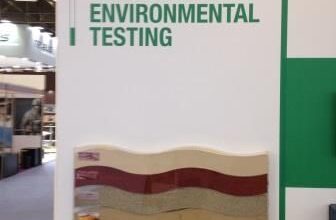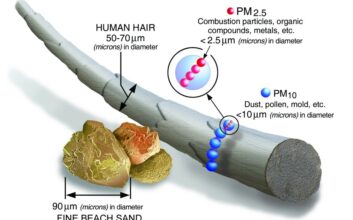Background
The World Health Organisation published these facts in 2018:
- Air pollution is a major environmental risk to health. By reducing air pollution levels, countries can reduce the burden of disease from stroke, heart disease, lung cancer, and both chronic and acute respiratory diseases, including asthma.
- The lower the levels of air pollution, the better the cardiovascular and respiratory health of the population will be, both long and short-term.
- The WHO Air Quality Guidelines: Global Update 2005 provide an assessment of health effects of air pollution and thresholds for health-harmful pollution levels.
- In 2016, 91% of the world population was living in places where the WHO air quality guidelines levels were not met.
- Ambient (outdoor air pollution) in both cities and rural areas was estimated to cause 4.2 million premature deaths worldwide in 2016.
- Some 91% of those premature deaths occurred in low- and middle-income countries, and the greatest number in the WHO South-East Asia and Western Pacific regions.
- Policies and investments supporting cleaner transport, energy-efficient homes, power generation, industry and better municipal waste management would reduce key sources of outdoor air pollution.
- In addition to outdoor air pollution, indoor smoke is a serious health risk for some 3 billion people who cook and heat their homes with biomass, kerosene fuels and coal.
They also drew some conclusions –
Addressing all risk factors for noncommunicable diseases – including air pollution – is key to protecting public health.
Most sources of outdoor air pollution are well beyond the control of individuals and demands concerted action by local, national and regional level policy-makers working in sectors like transport, energy, waste management, urban planning, and agriculture.
There are many examples of successful policies in transport, urban planning, power generation and industry that reduce air pollution:
- for industry: clean technologies that reduce industrial smokestack emissions; improved management of urban and agricultural waste, including capture of methane gas emitted from waste sites as an alternative to incineration (for use as biogas);
- for energy: ensuring access to affordable clean household energy solutions for cooking, heating and lighting;
- for transport: shifting to clean modes of power generation; prioritizing rapid urban transit, walking and cycling networks in cities as well as rail interurban freight and passenger travel; shifting to cleaner heavy-duty diesel vehicles and low-emissions vehicles and fuels, including fuels with reduced sulfur content;
- for urban planning: improving the energy efficiency of buildings and making cities greener and more compact, and thus energy efficient;
- for power generation: increased use of low-emissions fuels and renewable combustion-free power sources (like solar, wind or hydropower); co-generation of heat and power; and distributed energy generation (e.g. mini-grids and rooftop solar power generation);
- for municipal and agricultural waste management: strategies for waste reduction, waste separation, recycling and reuse or waste reprocessing; as well as improved methods of biological waste management such as anaerobic waste digestion to produce biogas, are feasible, low cost alternatives to the open incineration of solid waste. Where incineration is unavoidable, then combustion technologies with strict emission controls are critical.
It has been widely accepted that actions need to be taken and the launch of these new standards is a step towards being able to assess how effective a filtration system can be in making a positive impact on air quality.
Particles that can harm our health are referred to as Particulate Matter (Pm) and can be measured. WHO indicates that the range from Pm10 to Pm2.5 are significant in assessing health impacts.
Particulate Matter (Pm) Size Examples

- PM10 : inhalable particles, with diameters that are generally 10 micrometers and smaller; and
- PM2.5 : fine inhalable particles, with diameters that are generally 2.5 micrometers and smaller.
As part of the drive towards improving air quality, improve human health and save lives WHO encouraged world governments to take on initiatives at improving awareness and encouraging actions by individuals, organisations and business to achieving specific standards. Air Quality Monitoring stations were positioned globally to measure the effectiveness of these actions.
The data being generated is measured against Pm10 and Pm2.5 levels and is publicly available.
New Air Filter Test Standards for Filter Manufacturers in Industrial Air Filter Applications
There are 5 key International Standards that address the filtration efficiency, Arrestance and dust holding capacity and performance of air filters in an industrial environment.
In the USA, the American Society of Heating, Refrigeration and Air Conditioning Engineers (ASHRAE) publish a specification that has widely been used since 1999. Ashrae 52,2 2017 is the latest version.
In Europe EN779 has been the standard that addresses these features, with the latest specification EN779:2012, superseding EN779:2002.
For extremely high levels of particle removal (in air conditioning for example, or air filtration in operating theatres) then different standards apply. EN1822 is the standard most recognised traditionally, however, to bring clarity to the performance ISO 29463 has been released and will run alongside EN1822.
EN779 / Ashrae Classifications

EN1822/ISO29463 Classifications

ISO 16890
If we look at the new ISO16890, the main change is in classifying the performance of the filter and how it impacts the air that we breathe, by measuring how efficiently the filter works at removing the particulate matter (Pm). ISO 16890 has classifications that relate directly to Pm sizes of Pm10, Pm2.5 and Pm1.0, and how efficiently a filter removes these from air we breathe. This gives a meaningful indication of the impact any specific filter can have on removal of the harmful particle sizes stated by the WHO.
Classifications
Filters that are tested will achieve an efficiency rating at the various particle sizes. These are then reviewed against the following classifications and a result declared.
ISO ePM1ePM1, min ≥ 50 %
ISO ePM2,5ePM2,5, min ≥ 50 %
ISO ePM10ePM10 ≥ 50 %
ISO coarseePM10 < 50 %
However, unlike previous standards the actual efficiency level achieved within the classification will also be added to the classification within 5% band ranges.
For example if 2 air filters are tested and both achieve ePM1 classification, but one is achieving 69% and the other 76% then the test report will show classification of ePM1 65% for the first and ePM1 75% for the second. This gives the certain knowledge that the second filter will remove particles more efficiently than the first allowing the specifier or end user to make informed decisions on which to use.
Whilst this is all positive news and a great step forward for cleaner air, there are some applications of air filtration that have used the EN779 standard to assess the performance of air being filtered into some form of process e.g. electricity generation. Such air is not for human breathing and therefore how do they use the new standards to ensure the products they are buying meet their needs?
Particle Technology Ltd has the capability to test to both ISO16890 and EN779:2012 and can continue to provide these on an ongoing basis. As a UKAS Accredited and Independent test facility, manufacturers and users of filters can be sure that the results are truly representative on the tested filters performance.
Whilst the availability of dual testing is available to end users from Particle Technology, it is unlikely that filter manufacturers serving both market sectors, will absorb the cost of duplicate testing required on new products as they are developed. Particle Technology has alternative options that can assist industrial users looking at process air rather than breathing air – look out for our next paper with details in the coming few weeks.
 sales@particletechnology.com
sales@particletechnology.com




